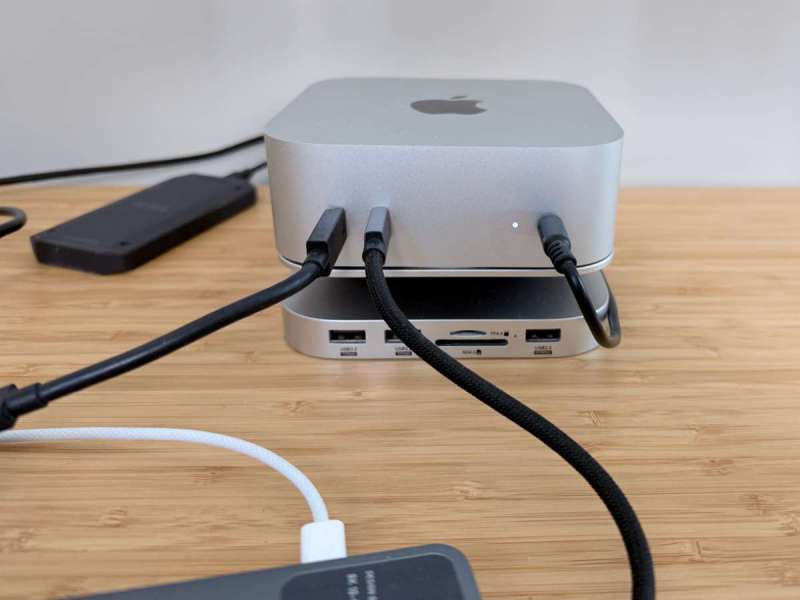
REVIEW – As soon as Apple released the Mac mini M4, I ordered the Pro version. It’s an insanely powerful computer that should last me for years. Although it has a pair of USB-C ports on the front and three Thunderbolt 4 ports on the back, I need more ports. I’ve been using CableTime’s 10-in-1 hub for this purpose; while it works well, I’d like to find a solution that can help me manage the cable spaghetti a bit better. To that end, I’ll be testing the new Mac mini M4 stand hub from Qwiizlab.
⬇︎ Jump to summary (pros/cons)
Price: $99.99
Where to buy: Qwiizlab and AliExpress
What is it?
This gadget (model UH60 Pro) combines a stand and a hub together into a single product. The stand lifts the mini off the desk, which should improve airflow and make it a bit easier to reach the on/off button, while the hub provides additional ports for my peripherals and an enclosure for an SSD drive.
What’s included?
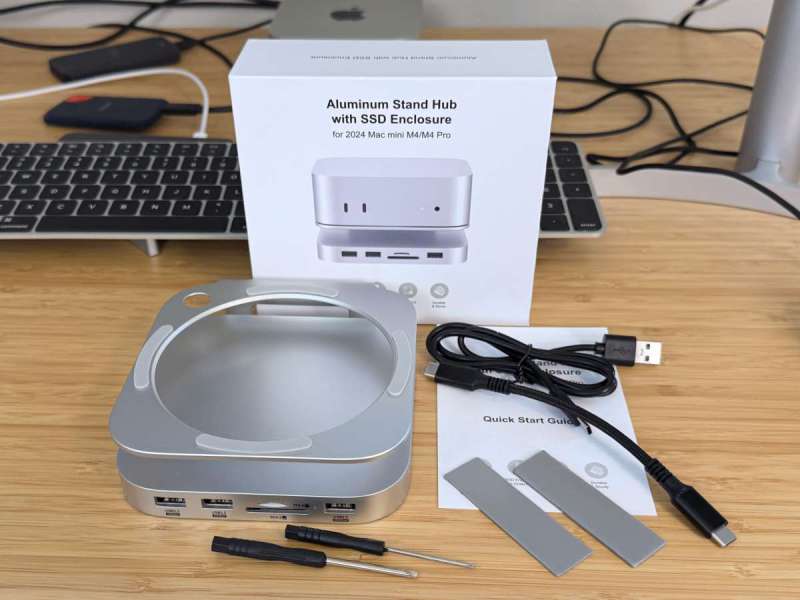
- The stand hub
- Two small screwdrivers
- USB-C cable
- USB-C to USB-A cable
- Two thermal heat pads
- Spare screws
- Quick start guide
Tech Specs
- Weight: 9.2 ounces
- Dimensions: 5 x 5.5 x 1.5 inches
- Material: Aluminum
- Ports: Two USB 3.2, one USB 2.0, SD and TF (USH-II)
- SSD: NVMe M.2
Qwiizlab has a list of compatible SSDs on their AliExpress page that includes name brands like Samsung, Western Digital, and Crucial. I purchase a 2TB Samsung 990 Pro from Amazon, the first SSD on the list.
Design and features
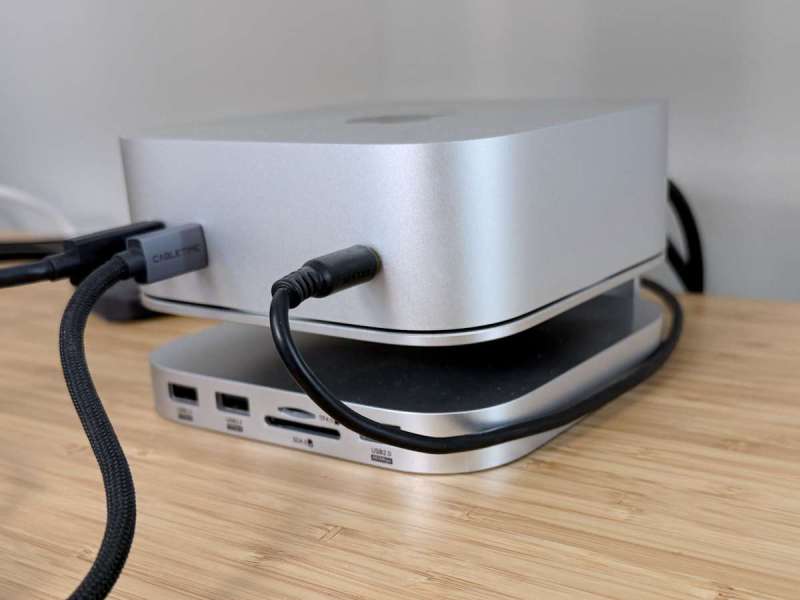
The stand hub has the same width and depth as the Mac mini and is nearly the same color. The mini fits perfectly on top, allowing easy access to the ports on the front and back and the power button underneath. My first impression is that this gadget has a clean, simple design that matches that of the mini.
Assembly, installation, and setup
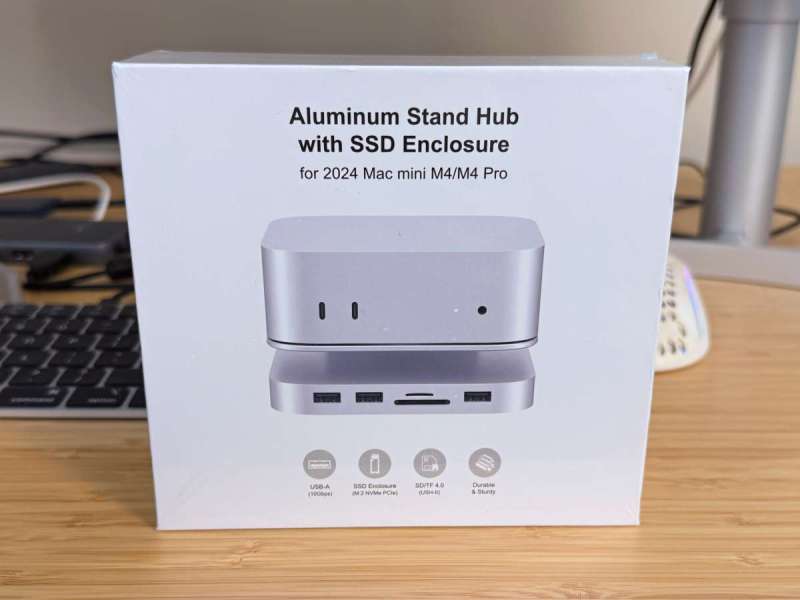
The stand hub arrived in a small, sturdy box with an aesthetic that almost matches that of Apple’s. I removed the stand hub from its packaging and inspected it.
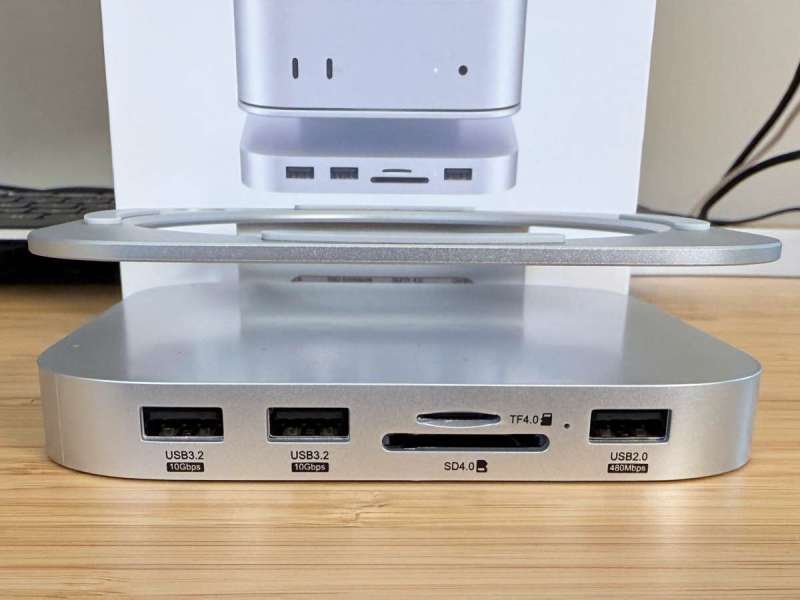
While it looks nice, I immediately noticed a problem: Although the stand is made of aluminum, the hub is made of plastic and painted a silver color. Qwiizlab’s page on AliExpress says that it’s made of aluminum; they don’t mention anything about plastic. My second impression is that I’ve been deceived.
Looking at the front, I see the USB-A ports and the TF and SD readers, all clearly marked. The manual notes, however, that these USB-A ports are only good for data; they cannot be used to charge another device, like my iPhone or my AirPods. That’s a significant degradation of capability. The top has four rubber feet that should hold the Mac mini securely in place.
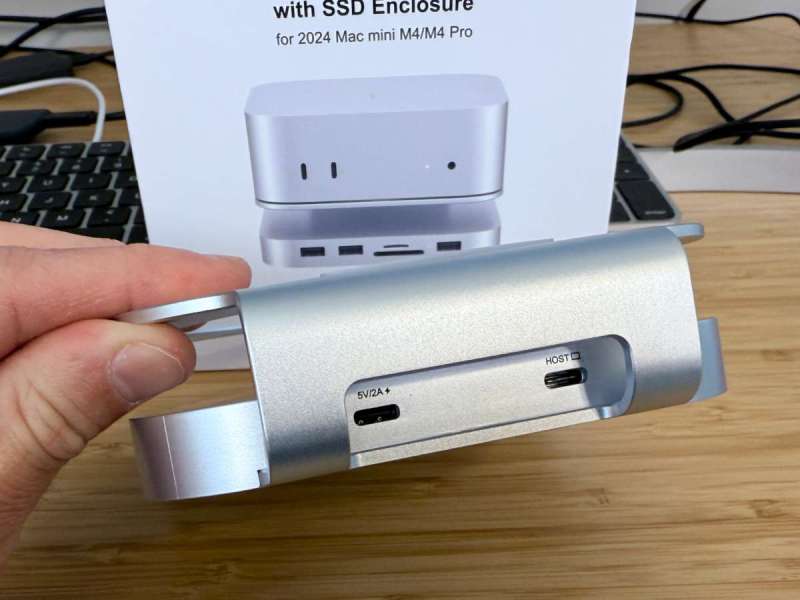
On the back, there are two USB-C ports. Reading through the manual, I learned that the host port should be connected to a Thunderbolt port on my Mac mini and the other should be connected to power. What?! Thunderbolt 4 supplies power; this stand hub should not need any external power source. It should also be able to charge other devices with the USB-A ports on the front. My third impression is that Qwiizlab failed to effectively utilize the capabilities of its host port. Although Qwiizlab supplied a very short USB-C cable for the host and a longer cable for charging, they didn’t supply a wall charger.
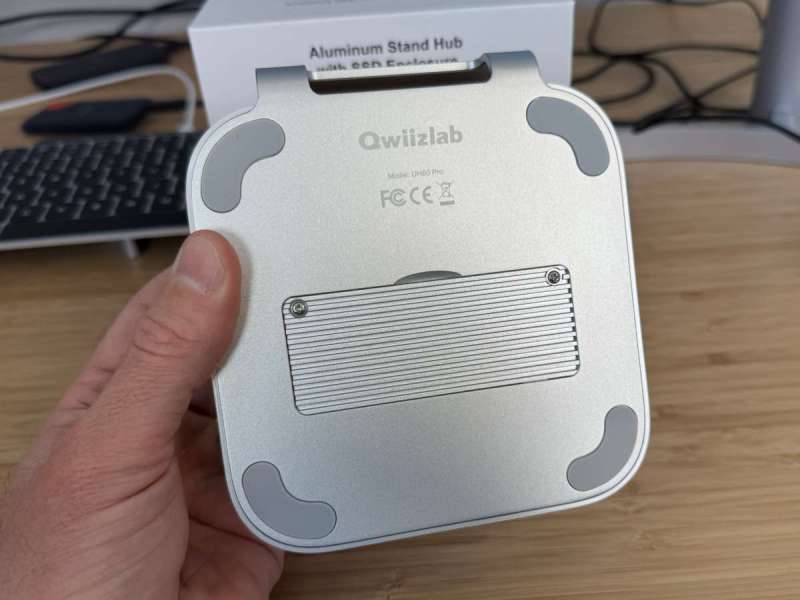
Looking underneath, I see four more rubber feet that should hold the stand hub in place on my desk. I also see where the enclosure is located.
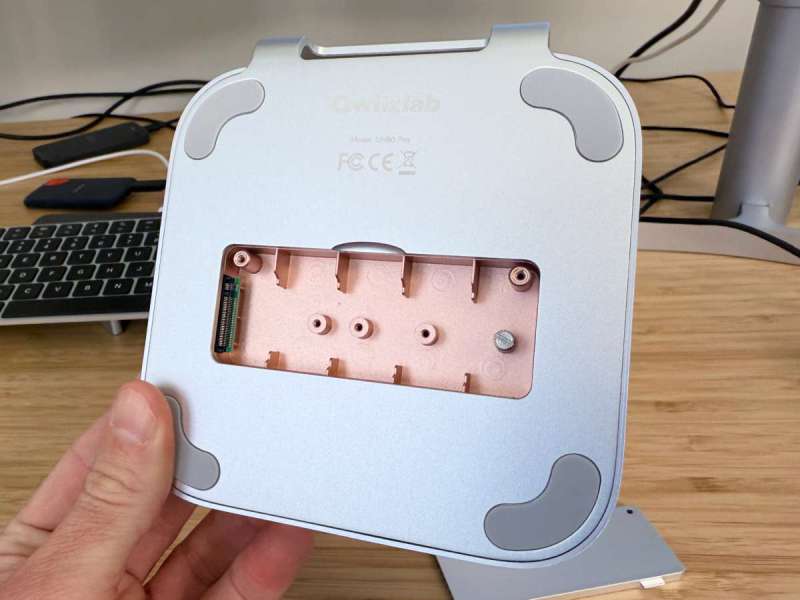
Removing the two screws, I found the enclosure for the SSD.
Performance

Here’s a depiction of my current computer setup that shows how I am using the Mac mini’s ports. I have a pair of LG 4k monitors and three external drives. One external drive is a SanDisk SSD for TimeMachine backup, one is an OWC SATA drive for Chronosync backup, and one is a SanDisk Thunderbolt 3 SSD for storing and editing media files. My Glorious D mouse is still USB-A, but my new Apple Magic keyboard and AirPods are both USB-C.
Thinking through the transition, I should be able to replace the older, slower SATA drive with the new Samsung SSD in the hub; this frees up the Thunderbolt 4 port required to connect to the hub. I can plug in my mouse into the hub, but I won’t be able to connect my keyboard or AirPods, since the hub doesn’t have any USB-C ports. This means that I’ll have to keep using the CableTime hub.
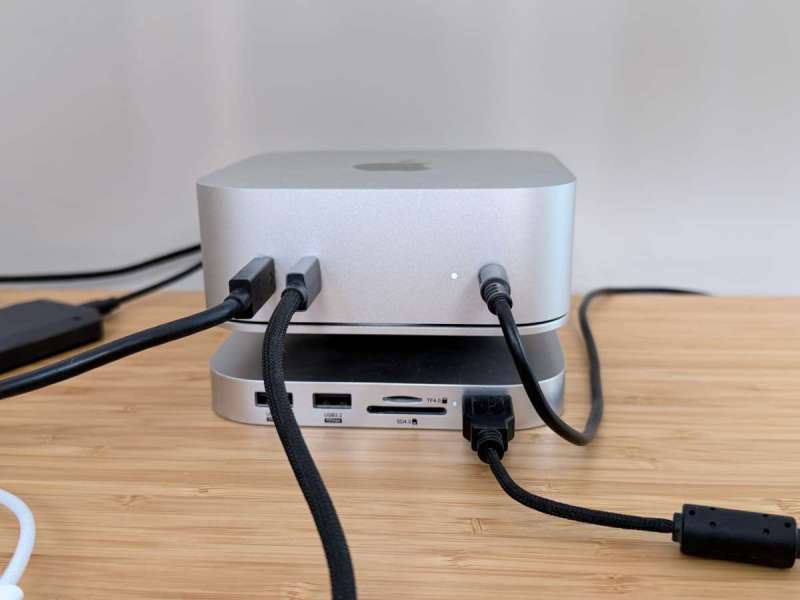
I decided to first test the stand hub without adding the SSD. The Mac mini sits on the stand and fits perfectly. I connected the Host port to a Thunderbolt port. The manual says that the hub requires a wall charger that has at least 20 W of power, so I used the one for my iPad Pro. I tested my mouse, an older Apple keyboard that uses USB-A, and a Samsung EVO TF card, and all worked as expected. This means that the hub is good to go.
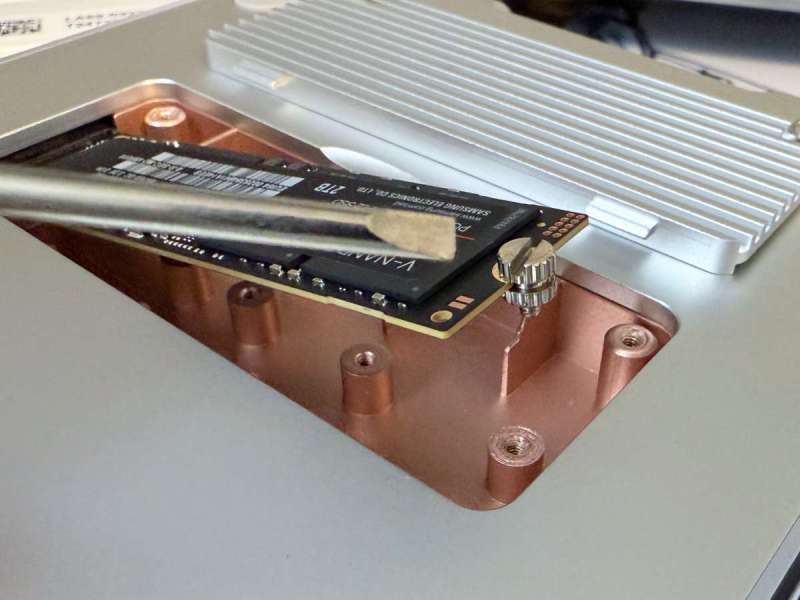
The next step is to add the SSD. The SSD fits into the NVMe M.2 slot. When I gently push the SSD down, it sits on a set of plastic ridges along each side. There’s a trick for using the strange, two-level screw that I had to learn. The center part slips into the slot on the end of the SSD, and then it can be screwed down in place. Qwiizlab’s manual doesn’t describe how to do this, but thankfully, I got a clear explanation from their marketing team.
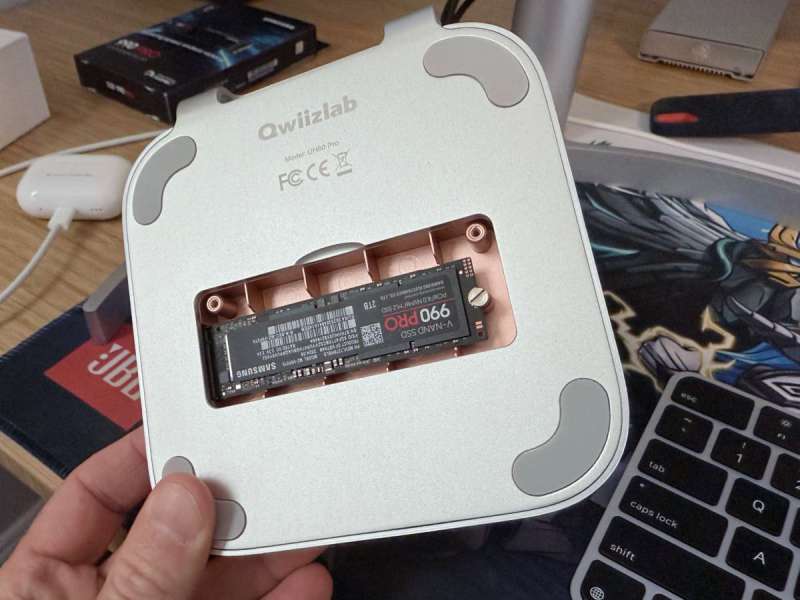
Once screwed in, the SSD was held firmly in place. The manual recommends adding one of the thermal heat pads, which appears to connect to the aluminum door. The door has ridges and is intended to function as a heat sink. I think there’s a problem with this design: the bottom of the stand hub is nearly flush with the desk, as the rubber pads on the bottom are thin. This means that there’s nowhere for the heat to go; it will be trapped under the stand hub. Qwiilab could improve their design by making the body of the stand hub aluminum so it’s all a heat sink, using taller feet to raise it up off the desk, or moving the heat sink to the side.
Once I reconnected the hub stand, Apple’s Disk Utility started up to help me properly format the newly found SSD. I formatted the drive as APFS and with the GUID Partition Map partition scheme. Everything worked, and my new SSD was now available in Finder.
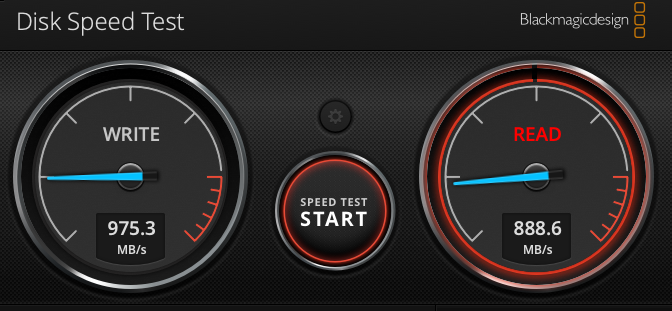
I moved some files back and forth without problem, and then I fired up BlackMagic’s RAW Speed Test. As seen above, I got less than 1000 MB/s for write and less than 900 for read. That’s pretty bad. This drive is capable of getting 3000 MB/s in an enclosure (and twice that if on a motherboard). This means that Qwiizlab once again cut corners on their interfaces and crippled this drive, limiting it to about 1/3 of its capability.
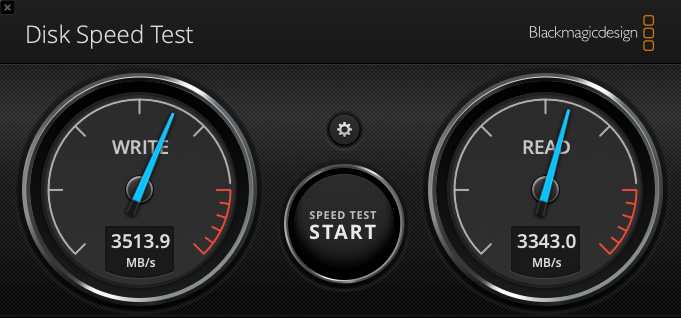
The ironic thing about this is that Qwiizlab knows how to make a fast SSD enclosure. After reading a couple of good reviews online, I bought this SSD enclosure from them. It works, and it’s super-fast. I got over 3500 MB/s for write and 3300 for read. I wish that they would have used this same technology for the stand hub.
Thinking about this gadget, I realized that it’s a tradeoff. I am giving up:
- Thunderbolt 4 (4O Gb/s)
- Power outlet
I am gaining:
- 2 USB 3.2 (10 Gb/s) ports and 1 USB 2.0 (0.5 Gb/s) that cannot charge
- SD and TF reader
- SSD enclosure with crippled speeds
Is this a good tradeoff? It depends. I was willing to pay for the Pro version of the M4, so clearly I’m looking for a very performant computer system. This stand hub doesn’t fit. I want a hub that uses the Thunderbolt 4 port for power and charging and interfacing with the SSD. I would be better off with a docking station that supports Thunderbolt 4 and provides both USB-C and USB-A ports, even if it doesn’t look as sleek as this stand hub, and I would be willing to pay more for it. On the other hand, the base model of the Mac mini M4 is only $600, so someone who is looking for a solid Apple computer while saving on costs as much as possible might find Qwiizlab’s gadget to be a good match.
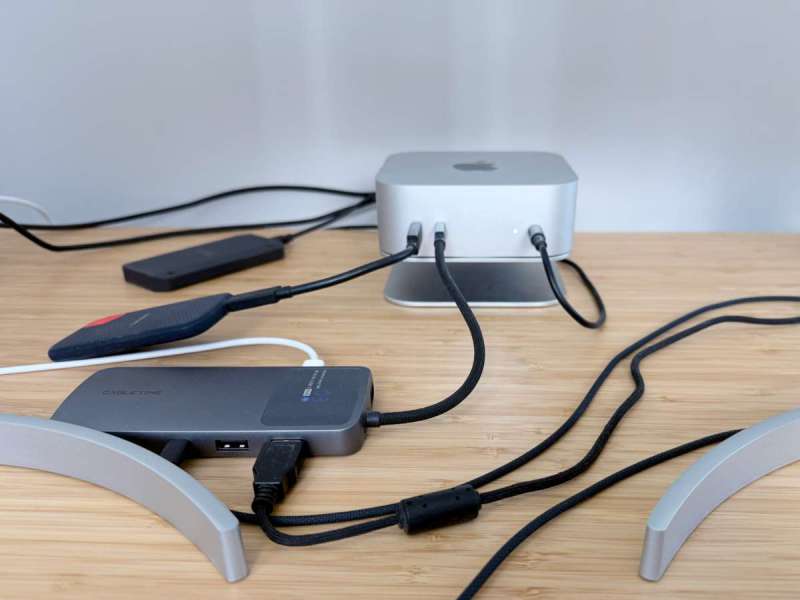
Qwiilab makes a couple of variations of this gadget. One includes an HDMI port, and the other has a stand without a hub. They graciously sent me the latter, so I put it into place. For now, I am using this stand, hoping that the extra airflow will keep my mini a bit cooler.
Final thoughts
I’m sure you’ve heard the old adage, “You get what you pay for.” I’m afraid that’s true for this gadget. It works effectively as a stand, raising my Mac mini into the air for improved airflow and easier access to the power button. It also provides three USB-A ports and a TF and SD reader. It requires a connection to a Thunderbolt 4 port, but it doesn’t effectively use that port. It needs an external power source and is unable to charge with the USB-A ports. Their AliExpress page says the stand hub is made of aluminum, but the hub is actually made of plastic. Altogether, this feels like a gadget whose maker cut as many corners as possible to save money. If you’re like me and want a hub with the performance to match your new Mac mini M4, then this is not the right gadget for you. If, however, you’re looking to save costs and are ok with the tradeoffs, then this sleek stand hub might be what you’re looking for.
What I like about the Qwiizlab Aluminum Stand Hub
- Clean, Apple-like design
- Efficient use of space
- Improved airflow
What needs to be improved?
- Be honest about product material (the hub is not aluminum)
- Power the USB-A ports
- Use power from the Thunderbolt 4 port instead of requiring external power
- Update the SSD enclosure to have better performance
- Provide better airflow to the “heat sink” for the SSD
Price: $69.66 – $99.99
Where to buy: Qwiizlab and AliExpress
Source: The sample for this review was provided free of charge by Qwiizlab. Qwiizlab did not have a final say on the review and did not preview the review before it was published.


Gadgeteer Comment Policy - Please read before commenting
I have a simpler solution to the heat-sink for the SSD issue here: Flip the mount of the SSD the other way around, build the heat transfer pad into the top of the mount, and have the *top* of the (bottom section of) stand be the heat sink.
I think you are saying, “Why not just keep the stand the same but flip the entire hub upside down?” This would give the door to the enclosure access to a lot more air and help it cool down. Good idea. This would, however, create a new problem: It would be hard to access the enclosure, as the stand would be in the way. To solve that, they would need to make the hub detachable from the stand. IOW, a pretty significant redesign. It would be easier IMHO to just put a couple of “fat feet” on the bottom to lift it up off the desk.
No, the only redesign needed would be to remove those stand-offs that the SSD is resting on, and instead put them on the removable bottom plate.
Basically, move the SSD inside the enclosure so that it’s resting on the top instead of the bottom. Same access, just move the mounting point inside it.
(Which probably does mean some redesign for the circuit board, now that I think about it, since it’s probably also resting on the bottom of the stand. But you could do a riser without much effort.)
Gotcha. TY for the clarification. I don’t really know what circuitry is in the rest of the stand or where it’s located, as there’s no way to open it up. Maybe it would have to be moved around or redesigned, maybe not.
Even so, the next problem is that the hub is made of plastic, not aluminum. It won’t help dissipate the heat. Qwiizlab would have to make the entire hub out of aluminum, or they would have to add an aluminum section to the top of it. Again, not a bad idea, but likely a lot of redesign.
This is a USB expansion hub, right, it doesn’t actually use the Thunderbolt port on the Mac Mini Pro as an applicable port. So, the performance of the drive is to be expected (it is at USB performance levels). The external TB drive enclosure is a TB base peripheral and then you get TB performance. If this company comes out with a true TB peripheral perhaps I’d buy it, but until then, no.
The host port is TB4, so I would expect the ports in this stand hub to take advantage of that. Qwiizlab chose not to do so, presumably to save cost.
And they do make a true TB4-capable peripheral, as I note in the review; just, unfortunately, not as part of this stand hub.
Yes, that’s what I said (they are only using the TB port as a USB port and get resultant speeds). I looked at this peripheral and decided against it a month or so ago. Bought a Mac Mini Pro as well, buying this would be crippling of its capabilities vs other available peripherals and was something I didn’t want to do.
Gotcha. And I agree all around.
I saw a lot of reports about issue wit wi-fi dropping due to the metal ring of the stand being so close to the wi-fi antennas in the mini. How was your experience.
I have been using just the aluminum stand (the version w/o the hub), and I have not had any WiFi issues.